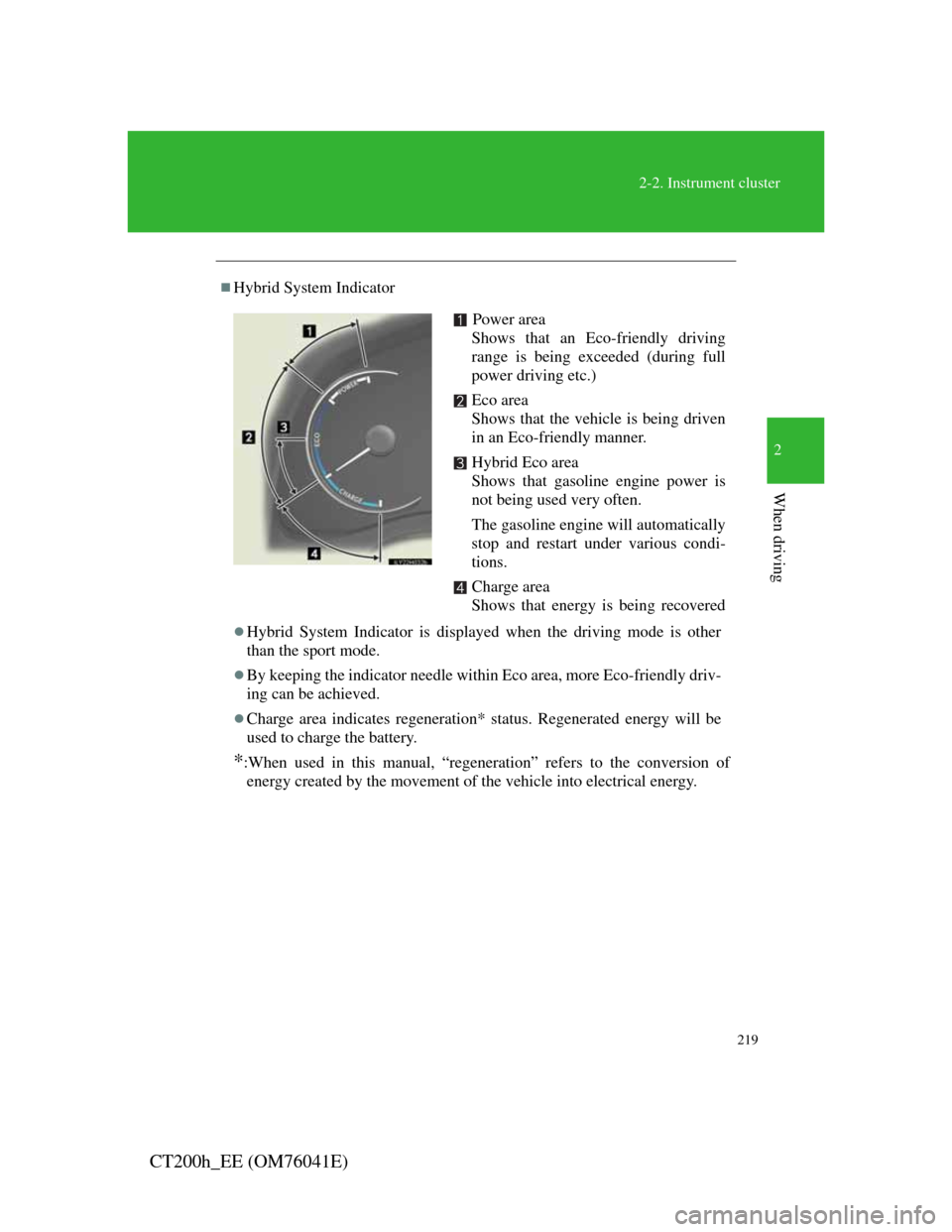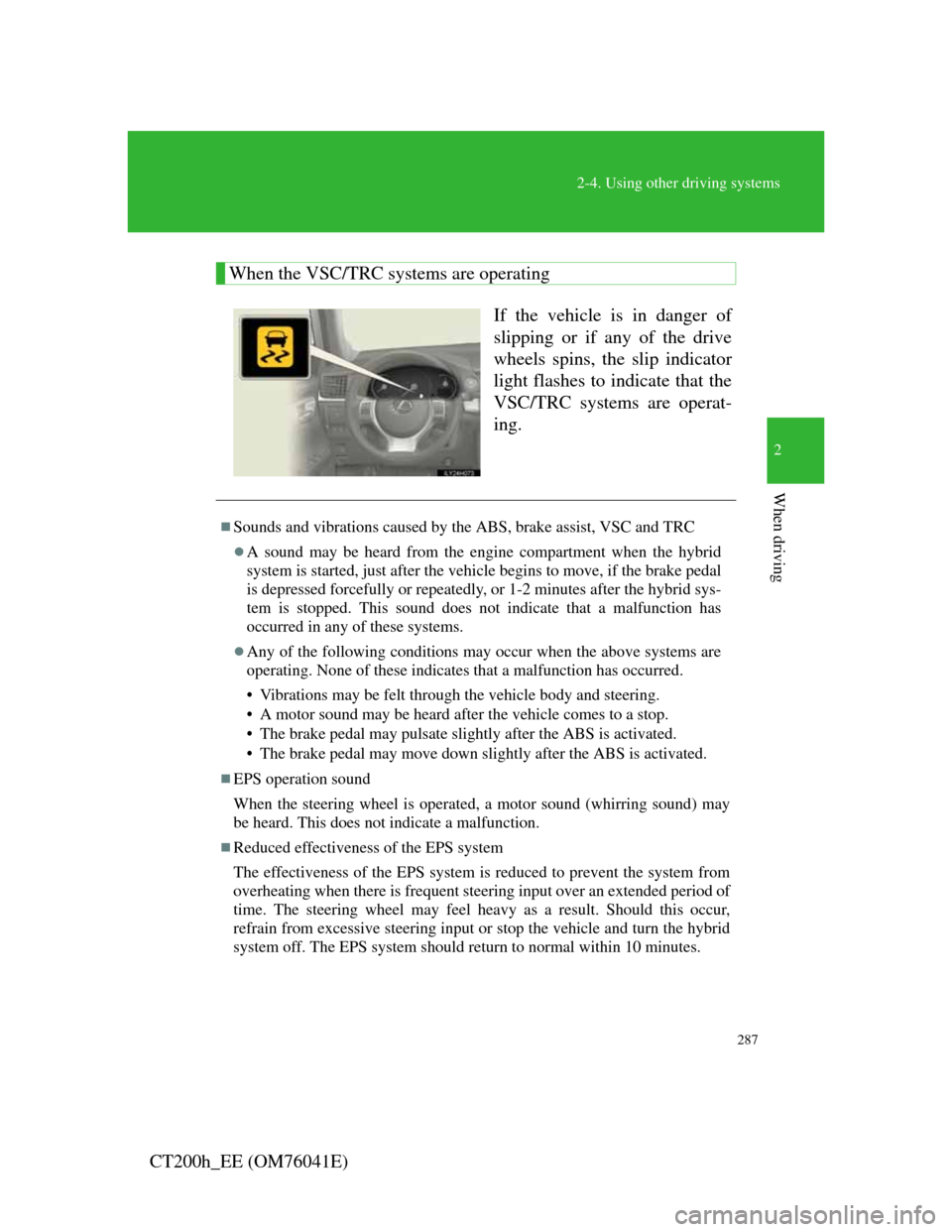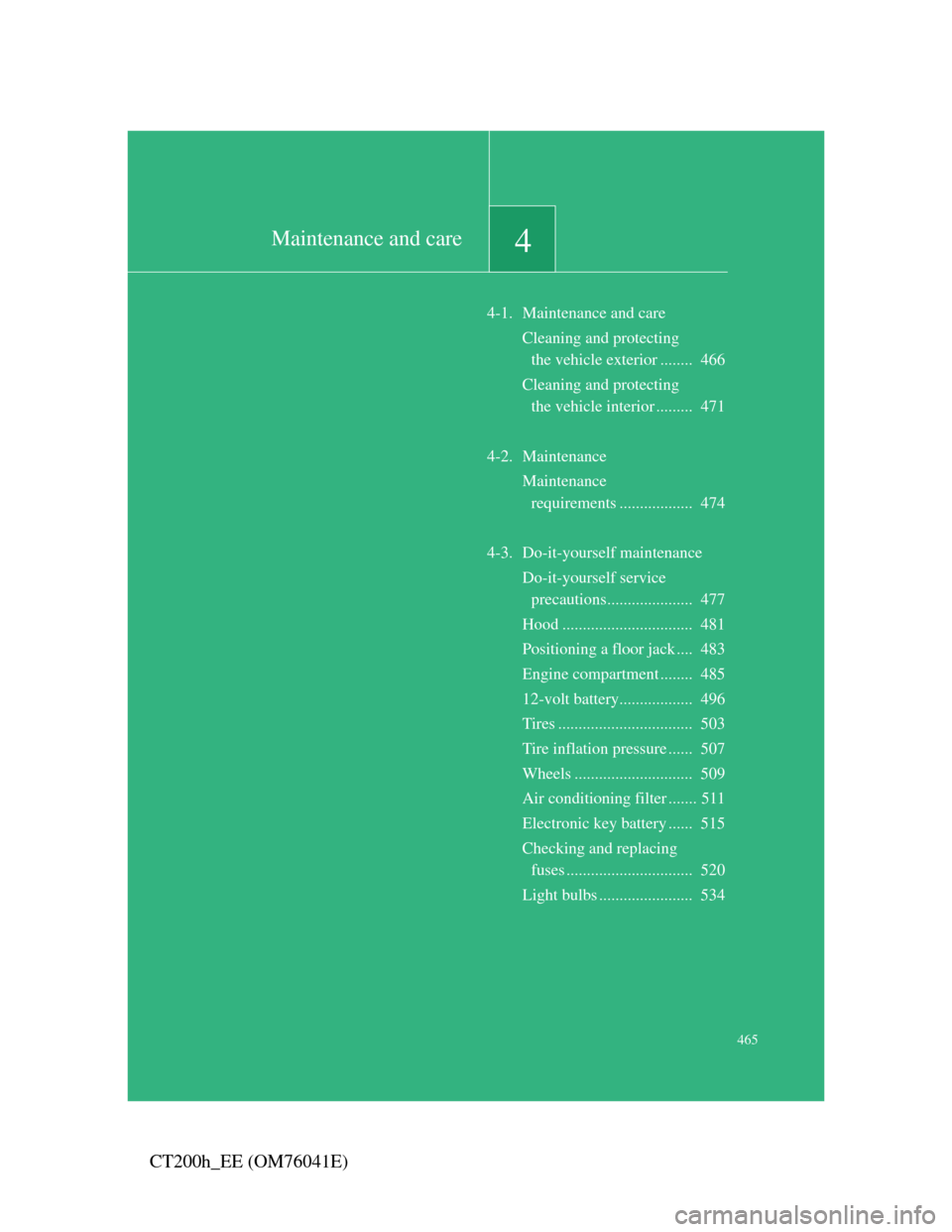engine Lexus CT200h 2011 (in English) Owner's Guide
[x] Cancel search | Manufacturer: LEXUS, Model Year: 2011, Model line: CT200h, Model: Lexus CT200h 2011Pages: 696
Page 211 of 696

211
2-1. Driving procedures
2
When driving
CT200h_EE (OM76041E)
CAUTION
When driving on slippery road surfaces
Do not accelerate or shift the shift position suddenly.
Sudden changes in engine braking may cause the vehicle to spin or skid,
resulting in an accident.
For the shift lever
Do not remove the shift lever knob or use anything but a genuine Lexus
shift lever knob. Also, do not hang anything on the shift lever.
Doing so could prevent the shift lever from returning to position, causing
unexpected accidents to occur when the vehicle is in motion.
P position switch
Do not press the P position switch while the vehicle is moving.
If the P position switch is pressed when driving at very low speeds (for
example, directly before stopping the vehicle), the vehicle may stop sud-
denly when the shift position switches to P, which could lead to an accident.
Page 216 of 696

216
CT200h_EE (OM76041E)
2-2. Instrument cluster
Gauges and meters
The following gauges and meters and display illuminate when the
“POWER” switch is in ON mode:
Hybrid System Indicator
Displays hybrid system output or regeneration level
Tachometer (if equipped)
Displays the engine speed in revolutions per minute
Speedometer
Displays the vehicle speed
ECO lamp and SPORT lamp (if equipped)
Changes colors according to driving mode
Fuel gauge
Displays the quantity of fuel remaining in the tank
Multi-information display
P. 226
Outside temperature
The temperature range that can be displayed is from -40 C (-40 F)
to 50 C (122 F)
Page 219 of 696

219
2-2. Instrument cluster
2
When driving
CT200h_EE (OM76041E)
Hybrid System Indicator
Hybrid System Indicator is displayed when the driving mode is other
than the sport mode.
By keeping the indicator needle within Eco area, more Eco-friendly driv-
ing can be achieved.
Charge area indicates regeneration* status. Regenerated energy will be
used to charge the battery.
*:When used in this manual, “regeneration” refers to the conversion of
energy created by the movement of the vehicle into electrical energy.
Power area
Shows that an Eco-friendly driving
range is being exceeded (during full
power driving etc.)
Eco area
Shows that the vehicle is being driven
in an Eco-friendly manner.
Hybrid Eco area
Shows that gasoline engine power is
not being used very often.
The gasoline engine will automatically
stop and restart under various condi-
tions.
Charge area
Shows that energy is being recovered
Page 220 of 696

220
2-2. Instrument cluster
CT200h_EE (OM76041E)
ECO lamp and SPORT lamp
When sport mode is selected, the SPORT lamp (red) will illuminate.
When all of the following conditions are satisfied and the Eco-friendly
driving, the ECO lamp (blue) will illuminate:
• When driving with the shift position in D
• When either normal mode or Eco mode are selected, and EV drive
mode is not in use
• The vehicle speed is 130 km/h (80 mph) or below.
Tachometer
Hybrid System Indicator automatically switches to the tachometer when the
driving mode is set to the sport mode. However, while the cruise control or
dynamic radar cruise control is active, Hybrid System Indicator will not
automatically switch to the tachometer. When the cruise control or dynamic
radar cruise control is activated while the tachometer is displayed, the
tachometer will automatically switch to Hybrid System Indicator.
Engine speed
On hybrid vehicles, engine speed is precisely controlled in order to help
improve fuel efficiency and reduce exhaust emissions etc.
There are times when the engine speed that is displayed may differ even
when vehicle operation and driving conditions are the same.
Outside temperature display
In the following situations, the correct outside temperature may not be dis-
played, or the display may take longer than normal to change.
When stopped, or driving at low speeds (less than 20 km/h [12 mph])
When the outside temperature has changed suddenly (at the entrance/exit
of a garage, tunnel, etc.)
Page 221 of 696

221
2-2. Instrument cluster
2
When driving
CT200h_EE (OM76041E)
Customization
Settings (e.g. on/off operation of the ECO lamp) can be changed.
(Customizable features P. 655)
NOTICE
To prevent damage to the engine and its components
Do not let the indicator needle of the tachometer enter the red zone, which
indicates the maximum engine speed.
The engine may be overheating if the high coolant temperature warning
light comes on or flashes. In this case, immediately stop the vehicle in a
safe place, and check the engine after it has cooled completely. (P. 6 2 7 )
Page 273 of 696

273
2-4. Using other driving systems
2
When driving
CT200h_EE (OM76041E)
Sensor detection information
Certain vehicle conditions and the surrounding environment may affect
the ability of a sensor to correctly detect an obstacle. Particular instances
where this may occur are listed below.
• There is dirt, snow or ice on a sensor.
• A sensor is frozen.
• A sensor is covered in any way.
• The vehicle is leaning considerably to one side.
• On an extremely bumpy road, on an incline, on gravel, or on grass
• The vicinity of the vehicle is noisy due to vehicle horns, motorcycle
engines, air brakes of large vehicles, or other loud noises producing
ultrasonic waves.
• There is another vehicle equipped with parking assist sensors in the
vicinity.
• A sensor is coated with a sheet of spray or heavy rain.
• The vehicle is equipped with a fender pole or radio antenna.
• Towing eyelets are installed.
• A bumper or sensor receives a strong impact.
• The vehicle is approaching a tall or right-angled curb.
• In harsh sunlight or intense cold weather
• A non-genuine Lexus suspension (lowered suspension etc.) is
installed.
In addition to the examples above, there are instances in which, because of
their shape, signs and other objects may be judged by a sensor to be closer
than they are.
The shape of the obstacle may prevent a sensor from detecting it. Pay
particular attention to the following obstacles:
• Wires, fences, ropes, etc.
• Cotton, snow and other materials that absorb sound waves
• Sharply-angled objects
•Low obstacles
• Tall obstacles with upper sections projecting outwards in the direction
of your vehicle
Page 287 of 696

287
2-4. Using other driving systems
2
When driving
CT200h_EE (OM76041E)
When the VSC/TRC systems are operating
If the vehicle is in danger of
slipping or if any of the drive
wheels spins, the slip indicator
light flashes to indicate that the
VSC/TRC systems are operat-
ing.
Sounds and vibrations caused by the ABS, brake assist, VSC and TRC
A sound may be heard from the engine compartment when the hybrid
system is started, just after the vehicle begins to move, if the brake pedal
is depressed forcefully or repeatedly, or 1-2 minutes after the hybrid sys-
tem is stopped. This sound does not indicate that a malfunction has
occurred in any of these systems.
Any of the following conditions may occur when the above systems are
operating. None of these indicates that a malfunction has occurred.
• Vibrations may be felt through the vehicle body and steering.
• A motor sound may be heard after the vehicle comes to a stop.
• The brake pedal may pulsate slightly after the ABS is activated.
• The brake pedal may move down slightly after the ABS is activated.
EPS operation sound
When the steering wheel is operated, a motor sound (whirring sound) may
be heard. This does not indicate a malfunction.
Reduced effectiveness of the EPS system
The effectiveness of the EPS system is reduced to prevent the system from
overheating when there is frequent steering input over an extended period of
time. The steering wheel may feel heavy as a result. Should this occur,
refrain from excessive steering input or stop the vehicle and turn the hybrid
system off. The EPS system should return to normal within 10 minutes.
Page 304 of 696

304
2-5. Driving information
CT200h_EE (OM76041E)
Winter driving tips
Carry out the necessary preparations and inspections before driving
the vehicle in winter. Always drive the vehicle in a manner appropriate
to the prevailing weather conditions.
Pre-winter preparations
Use fluids that are appropriate to the prevailing outside
temperatures.
• Engine oil
• Engine/power control unit coolant
• Washer fluid
Have the vehicle fitted with four snow tires or purchase a
set of tire chains for the front tires.
Ensure that all tires are the same size and brand, and that chains
match the size of the tires.
Before driving the vehicle
Perform the following according to the driving conditions:
Do not try to forcibly open a window or move a wiper that
is frozen. Pour warm water over the frozen area to melt the
ice. Wipe away the water immediately to prevent it from
freezing.
To ensure proper operation of the climate control system
fan, remove any snow that has accumulated on the air inlet
vents in front of the windshield.
Remove any ice that has accumulated on the vehicle chas-
sis.
Page 320 of 696

320
3-1. Using the air conditioning system and defogger
CT200h_EE (OM76041E)
Pollen removal mode
In order to prevent the windshield from fogging up when the outside air
is cold, the following may occur:
• Outside air mode does not switch to (recirculated air) mode.
• The air conditioning system operates automatically.
• The operation cancels after 1 minute.
In rainy weather, the windows may fog up. Press .
When outside air temperature is below 0 C (32 F)
The cooling and dehumidification function may not operate even when
is pressed.
Operation of the air conditioning system in Eco drive mode
In the Eco drive mode, the air conditioning system is controlled as follows
to prioritize fuel efficiency:
Engine speed and compressor operation controlled to restrict heating/
cooling capacity
Fan speed restricted when automatic mode is selected
To improve air conditioning performance, perform the following operations:
Adjust the fan speed
Turn off Eco drive mode
Customize the air conditioning control of Eco drive mode. (P. 655)
Page 465 of 696

4Maintenance and care
465
CT200h_EE (OM76041E)
4-1. Maintenance and care
Cleaning and protecting
the vehicle exterior ........ 466
Cleaning and protecting
the vehicle interior ......... 471
4-2. Maintenance
Maintenance
requirements .................. 474
4-3. Do-it-yourself maintenance
Do-it-yourself service
precautions..................... 477
Hood ................................ 481
Positioning a floor jack .... 483
Engine compartment ........ 485
12-volt battery.................. 496
Tires ................................. 503
Tire inflation pressure ...... 507
Wheels ............................. 509
Air conditioning filter ....... 511
Electronic key battery ...... 515
Checking and replacing
fuses ............................... 520
Light bulbs ....................... 534